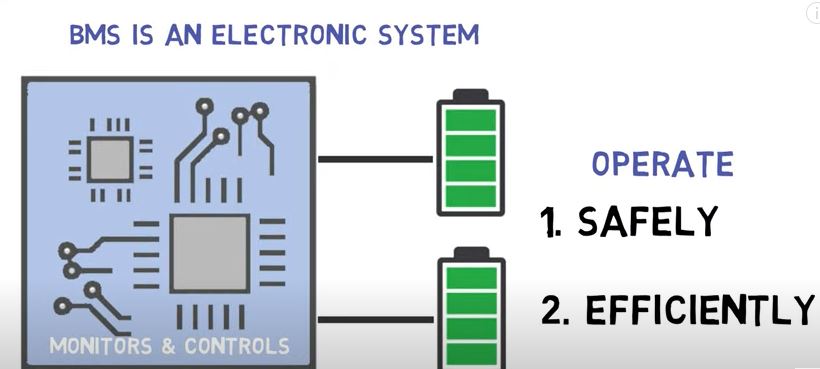A battery management system (BMS) is a device that regulates the charging and discharging of batteries. It protects batteries from overcharging and over-discharging and extends their life. A BMS also balances the cells in a battery pack, so that they all have the same voltage and capacity.

A battery management system (BMS) is a critical component in any application where batteries are used. Its purpose is to protect the batteries from operating outside their safe limits and to maximize their performance and lifetime. There are three primary functions of a BMS:
| 1 | Monitoring | The BMS continuously monitors the state of charge (SOC), state of health (SOH), and temperature of each cell in the battery pack. This information is used to optimize the operation of the battery pack, and to prevent damage from over-charging, over-discharging, or excessive temperatures. |
| 2 | Balancing | The BMS balances the cells in the battery pack by equalizing their voltages. This ensures that all cells are at the same SOC, which maximizes performance and lifetime. |
| 3 | Protection | The BMS protects the battery pack from damage by disconnecting it from the load or charger if any cell voltage exceeds its safe limit. This prevents cells from being over-charged or over-discharged, which can lead to permanent damage or failure. |
Disadvantages of Battery Management System
As we all know, the battery management system is very important for electric vehicles. It can help to improve the range and performance of the car. However, there are also some disadvantages of battery management systems.
| First | The first disadvantage is that it can be expensive. The cost of a good quality battery management system can be quite high and it can also be difficult to find one that fits your specific car model. |
| Second | Another downside of using a battery management system is that it can add extra weight to your car. This might not be an issue for some people but if you are trying to save weight on your vehicle, then this could be a problem. |
| Final | Lastly, battery management systems can sometimes be tricky to install and they might not work correctly if they are not installed properly. |
If you are not experienced in installing them, then it is best to leave this task to the professionals.
What is Battery Management System for Electric Vehicles?
The battery management system (BMS) is a critical component in any electric vehicle (EV). Its main purpose is to protect the battery pack from damage and to ensure its safe and efficient operation. The BMS does this by monitoring the individual cell voltages and temperatures, as well as the overall pack voltage and temperature.
If any of these parameters exceed their safe limits, the BMS will take action to prevent further damage. One of the most important functions of the BMS is balancing. This is accomplished by periodically equalizing the voltages of all cells in the pack.
This ensures that each cell gets an equal amount of charge/discharge cycles, which helps to prolong the life of the entire pack. The BMS also provides information about the state of charge (SOC) of the battery pack. This is important for both range estimation and safety purposes.
Knowing how much charge is remaining in the pack allows drivers to plan their trips accordingly, and also helps to prevent accidental over-discharging, which can damage the cells irreversibly. There are many different types and sizes of BMSs available on the market today. Selecting one that is appropriate for your application will require careful consideration of several factors, including voltage/current ratings, the number of cells supported, features offered, communication interface options, etc.
Be sure to consult with an expert before making your final decision!
Types of Battery Management Systems
There are many types of battery management systems (BMS) on the market. Each type has its own advantages and disadvantages. The most common types of BMS are:
1. Linear BMS
A linear BMS is the simplest and most common type of BMS. It uses a single central processor to control all the cells in a battery pack. Linear BMS are typically less expensive than other types of BMS, but they are also less flexible and can’t handle as much power.
2. Modular BMS
A modular BMS is made up of multiple smaller units, each of which controls a portion of the battery pack. This allows for more flexibility and higher power handling, but it also makes modular BMS more expensive than linear BMS.
3. Distributed BMS
A distributed BMS is similar to a modular BMS, but each unit in a distributed BMS controls only one cell in the battery pack.
This makes distributed BMS even more flexible than modular BMSNs, but it also makes them even more expensive.
Battery Management System Requirements

A battery management system (BMS) is a critical component in any application where lithium-ion batteries are used. The BMS ensures the safe and efficient operation of the batteries by monitoring their voltage, current, and temperature, and managing their charge and discharge cycles. The requirements for a BMS vary depending on the specific application, but there are some common features that all BMSes must have:
1. Voltage Monitoring
The BMS must be able to measure the voltage of each individual cell in the battery pack. This information is used to determine the state of charge (SOC) of the battery, as well as to detect any cells that are over-voltage or under-voltage.
2. Current Monitoring
The BMS must be able to measure the current flowing into and out of the battery pack.
This information is used to calculate the energy consumption of the system, as well as to detect any abnormal currents that could indicate a fault condition.
3. Temperature Monitoring
The BMS must be able to measure the temperature of each individual cell in the battery pack. This information is used to ensure that the batteries operate within their safe temperature range and to detect any cells that are overheating.
4. Charge/Discharge Control
The BMS must be able to control when charging and discharging occurs, based on pre-set parameters such as SOC thresholds or maximum discharge rates. This ensures that the batteries are not overcharged or discharged too deeply, which can shorten their lifespan or cause damage.
Components of Battery Management System
A battery management system (BMS) is a system that monitors and manages the performance of a battery pack. The BMS ensures that the cells in the battery pack are within their safe operating limits, prolongs the life of the battery pack, and provides data for diagnostic purposes. The main components of a BMS are:
Battery Monitoring ICs
These integrated circuits monitor various parameters of each cell in the battery pack, such as voltage, current, temperature, and state of charge. The data from the ICs are used to control the operation of the battery pack.
Communication Interface
This component allows the BMS to communicate with other devices, such as a charger or an inverter. The communication interface can be either wired or wireless.
Protection Circuitry
This circuitry protects the cells in the event of overvoltage, under voltage, overcurrent, or overtemperature conditions. the protection circuit may also disconnect faulty cells from the rest of the pack.
Pack assembly: The individual cells in a battery pack must be physically connected together; this is typically done by welding or soldering tabs on the cells to bus bars.
BMS for Lithium Ion Battery
Lithium-ion batteries are one of the most popular types of batteries on the market today. They are used in a wide variety of devices, from cell phones to laptops. BMS stands for battery management system.
A good BMS will extend the life of your lithium-ion battery and protect it from overcharging or damage. When shopping for a BMS, there are a few things you should keep in mind.
- First, make sure that the BMS you choose is compatible with the type of lithium-ion battery you have.
- Second, consider the features that are important to you. Some BMSs come with built-in chargers, while others do not. Make sure to choose a BMS that has all the features you need.
Once you have found the perfect BMS for your needs, it is important to follow the instructions for installation and use carefully. Improper installation or use can void your warranty or cause damage to your battery. If you have any questions about installation or use, be sure to consult with customer service before proceeding.
Battery Management System for Electric Vehicle PPT
A battery management system (BMS) is a critical component in any electric vehicle (EV). It ensures that the batteries are used efficiently and safely, and can extend their life. The BMS monitors the state of charge (SOC) of the batteries and controls charging and discharging.
It also protects the batteries from overcharging, overheating, and deep discharge. Most BMS systems are made up of three parts: a control unit, sensors, and actuators. The control unit is the brain of the system, receiving input from the sensors and sending output to the actuators.
The sensors monitor various parameters such as voltage, current, temperature, and SOC. The actuators include switches that control charging and discharging, as well as cooling fans for thermal management. Many EV manufacturers offer BMS solutions that are integrated into their vehicles.
For example, Tesla’s Model S has an onboard BMS that manages the battery pack made up of thousands of individual cells. Other companies make standalone BMS units that can be retrofitted to existing EVs.
Battery Management System
Most people are familiar with the concept of a battery management system (BMS), but few know how these systems actually work. A BMS is a device that is used to monitor and control the charging and discharging of batteries. This can be used in conjunction with a charger to ensure that the batteries are charged correctly, or it can be used on its own to prevent overcharging or discharge.
A typical BMS will have a number of different functions, all designed to keep the battery pack working at its best. These include monitoring individual cell voltages, temperature, and current; balancing cells; protecting against overcharge and discharge, and providing information about the status of the battery pack. Some BMSs also have features such as data logging and remote monitoring, which can be very useful for troubleshooting or monitoring purposes.
Installing a BMS is not always straightforward, and it is important to make sure that it is compatible with the rest of your system before you start. Once installed, however, a good BMS will give you peace of mind knowing that your batteries are being properly monitored and protected.

What is the Function of a Battery Management System?
Most people are familiar with the term “battery management system” (BMS), but few know what it actually refers to. A BMS is an electronic device that monitors and regulates the charging and discharge of a battery, ensuring optimal performance and prolonging its lifespan. The primary function of a BMS is to protect the battery from being overcharged or discharged beyond its safe operating limits.
It does this by continuously monitoring the battery’s voltage, current, and temperature, and then controlling the charging and discharging process accordingly. For example, if the BMS detects that the battery is becoming too hot, it will automatically stop charging or discharging until the temperature drops to a safe level. Similarly, if the battery is discharged below a certain threshold voltage, the BMS will cut off power to prevent further damage.
In addition to safety features, a good BMS will also improve the overall performance of your battery pack. For instance, many BMS systems include a balancing feature that helps distribute charge evenly across all cells in a multi-cell battery pack. This can help prevent capacity loss and prolongs the life of your batteries.
If you’re considering adding a BMS to your existing battery pack or purchasing a pre-assembled pack with one already installed, be sure to do your research first. There are many different types of BMS systems on the market, so it’s important to choose one that’s compatible with your specific needs.
What are the Types of Battery Management Systems?
A battery management system (BMS) is a device or group of devices that monitors, regulates, and protects batteries from overcharging, excessive discharge, and overheating. A BMS can be used with any type of battery pack, including those made up of lithium-ion (Li-ion), lead acid, nickel metal hydride (NiMH), or nickel-cadmium (NiCd) cells. There are three primary types of BMS:
| 1 | Overcharge protection BMS | This type of BMS prevents batteries from being charged beyond their maximum voltage limit. It does this by cutting off power to the charger when the maximum voltage is reached. |
| 2 | Discharge protection BMS | This type of BMS prevents batteries from being discharged below their minimum voltage limit. It does this by cutting off power to the load when the minimum voltage is reached. |
| 3 | Temperature protection BMS | This type of BMS prevents batteries from being exposed to excessively high or low temperatures. It does this by monitoring the temperature of the battery pack and shutting off power to the charger or load if the temperature exceeds its safe limits. |
What are the Functions of a Battery ECU Or Battery Management System?
The battery ECU or battery management system is a key component in any modern electric or hybrid vehicle. Its primary function is to monitor and manage the state of charge of the vehicle’s batteries, ensuring that they are always operating within their safe operating limits. The battery ECU also regulates the charging and discharging of the batteries, maximizing their lifespan and performance.
In addition, the battery ECU provides diagnostic information about the health of the batteries to the rest of the vehicle’s systems.
What is the Function of a BMS Battery Management System in the Electric Vehicle?
BMS stands for Battery Management System. It is a system that manages, monitors, and protects the battery pack in an electric vehicle (EV). The BMS ensures that the battery pack is operating within its safe limits, prolonging its life and maximizing its performance.
The BMS consists of various sensors and controllers that monitor the status of each individual cell in the battery pack. The data from these sensors is used to calculate the state of charge (SOC), state of health (SOH), and state of function (SOF) of the battery pack. The BMS also has safety features that protect the battery pack from overcharging, over-discharging, overheating, and short-circuiting.
The BMS is essential for ensuring that the EV battery pack lasts for as long as possible and performs at its best.
Summary
Most people are not aware that a battery management system (BMS) exists in their cars. BMS is a computerized system that monitors and regulates the charging and discharging of the battery pack in order to maximize its performance and longevity. The main functions of BMS are:
1. To protect the battery pack from overcharging or deep discharge, which can damage it.
2. To balance the individual cells in the battery pack so that they all have equal voltage and capacity. This ensures that the pack works at its optimum level and extends its life.
3. To monitor the temperature of the battery pack and keep it within safe limits, as high temperatures can also damage it.
4. To provide information to the driver about the state of charge of the battery pack, so that they can take appropriate action to conserve power if necessary.
Used Resources:
